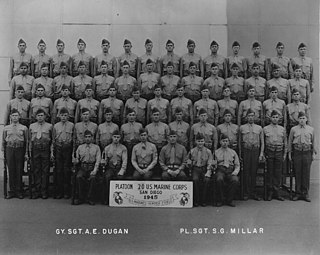Related Research Articles

A battalion is a military unit, typically consisting of up to one thousand soldiers commanded by a lieutenant colonel and subdivided into a number of companies, each typically commanded by a major or a captain. The typical battalion is built from three operational companies, one weapons company and one headquarters company. In some countries, battalions are exclusively infantry, while in others battalions are unit-level organisations.
A company is a military unit, typically consisting of 100–250 soldiers and usually commanded by a major or a captain. Most companies are formed of three to seven platoons, although the exact number may vary by country, unit type, and structure.
Military ranks are a system of hierarchical relationships within armed forces, police, intelligence agencies and other institutions organized along military lines. Responsibility for personnel, equipment and missions grow with each advancement. The military rank system defines dominance, authority and responsibility within a military hierarchy. It incorporates the principles of exercising power and authority into the military chain of command—the succession of commanders superior to subordinates through which command is exercised. The military chain of command is an important component for organized collective action.

A regiment is a military unit. Its role and size varies markedly, depending on the country, service, or specialisation.

A platoon is a military unit typically composed of two to four squads, sections, or patrols. Platoon organization varies depending on the country and the branch, but a platoon can be composed of 20–50 troops, although specific platoons may range from 10 to 100 people. A platoon is typically the smallest military unit led by a commissioned officer. The platoon leader is usually a junior officer—a second or first lieutenant or an equivalent rank. The officer is usually assisted by a platoon sergeant.
Corporal is a military rank in use by the armed forces of many countries. It is also a police rank in some police services. The rank is usually the lowest ranking non-commissioned officer. In some militaries, the rank of corporal nominally corresponds to commanding a section or squad of soldiers.

Miniature wargaming is a form of wargaming in which military units are represented by miniature physical models on a model battlefield. The use of physical models to represent military units is in contrast to other tabletop wargames that use abstract pieces such as counters or blocks, or computer wargames which use virtual models. The primary benefit of using models is aesthetics, though in certain wargames the size and shape of the models can have practical consequences on how the match plays out.

During the American Civil War, the United States Army, the land force that fought to preserve the collective Union of the states, was often referred to as the Union Army, the Federal Army, or the Northern Army. It proved essential to the restoration and preservation of the United States as a working, viable republic.

A section is a military sub-subunit. It usually consists of between 6 and 20 personnel. NATO and U.S. doctrine define a section as an organization "larger than a squad, but smaller than a platoon." As such, two or more sections usually make up an army platoon or an air force flight.

An artillery observer, artillery spotter, or forward observer (FO) is a soldier responsible for directing artillery and mortar fire support onto a target. An artillery observer usually accompanies a tank or infantry unit. Spotters ensure that indirect fire hits targets which those at a fire support base cannot see.

The Battle of El Caney was fought on July 1, 1898, during the Spanish-American War. 600 Spanish soldiers held for twelve hours, until they ran out of ammunition, against Henry W. Lawton's 5th US Division, made up of 6,899 men. This action temporarily delayed the American advance on the San Juan Hills, as had been requested of General William Rufus Shafter. Nevertheless, American forces advanced on San Juan Hill the same day. Though encountering spirited resistance similar to El Caney, the Americans were ultimately victorious, culminating in the capitulation of the Spanish garrison.

An infantry square, also known as a hollow square, was a historic close order formation used in combat by infantry units, usually when threatened with cavalry attack. To deploy its weapons effectively, a traditional infantry unit would generally form a line; but the line was vulnerable to more nimble cavalry, which could sweep around the end of the line, or burst through it, and then attack the undefended rear or simply sweep along the line attacking the individual footsoldiers successively. By arranging the unit so that there was no undefended rear or flank, an infantry commander could organise an effective defense against cavalry attack. With the development of modern firearms and the demise of cavalry, the square formation is now considered obsolete.

Infantry tactics are the combination of military concepts and methods used by infantry to achieve tactical objectives during combat. The role of the infantry on the battlefield is, typically, to close with and engage the enemy, and hold territorial objectives; infantry tactics are the means by which this is achieved. Infantry commonly makes up the largest proportion of an army's fighting strength, and consequently often suffers the heaviest casualties. Throughout history, infantrymen have sought to minimise their losses in both attack and defence through effective tactics.

The Dominican Army (Spanish: Ejército de República Dominicana, is one of the three branches of the Armed Forces of the Dominican Republic, together with the Navy and the Air Force.

The structure of the United States Army is complex, and can be interpreted in several different ways: active/reserve, operational/administrative, and branches/functional areas.

The Battle of Ka-san was an engagement between United Nations Command (UN) and North Korean forces early in the Korean War from September 1 to September 15, 1950, in the vicinity of Ka-san , Chilgok County in South Korea. It was a part of the Battle of Pusan Perimeter, and was one of several large engagements fought simultaneously. The battle ended in a victory for the United Nations after large numbers of United States Army (US) and Republic of Korea Army (ROK) troops repelled a strong Korean People's Army (KPA) attack.
The Battle of Robănești is a confrontation which took place between Romanian and German troops during the Romanian Campaign of World War I.

The Royal Sardinian Army was the army of the Duchy of Savoy and then of the Kingdom of Sardinia, which was active from 1416 until it became the Royal Italian Army on 4 May 1861.
A regiment is a military unit that has been in use by the United States Army since its inception. Derived from the concept originating in European armies, a regiment was historically commanded by a colonel, and consisted of ten companies, for a total of approximately 1,000 soldiers. Confusingly, the terms "regiment" and "battalion" were used interchangeably at this time; it was not until later that a battalion was defined as a sub-unit of a regiment. The regiment fulfilled both administrative and tactical functions and was the principal maneuver unit of the US Army until being superseded in the 20th century by the division.
A company is a military unit of the United States Army which has been in use since the American Revolutionary War. It has historically been commanded by a captain, assisted by a first sergeant as the senior-most non-commissioned officer (NCO), and consisted of approximately one hundred soldiers. Soldiers were divided between three and five platoons of around thirty each and led by a lieutenant. However the exact size and composition of a company has varied depending on the time period and its role.
References
- ↑ "Brother Against Brother (Revised & Expanded)". Noble Knight Games. Retrieved 23 August 2024.
- 1 2 "ACW LAND WARFARE: Brother Against Brother". The Miniatures Page. Retrieved 23 August 2024.